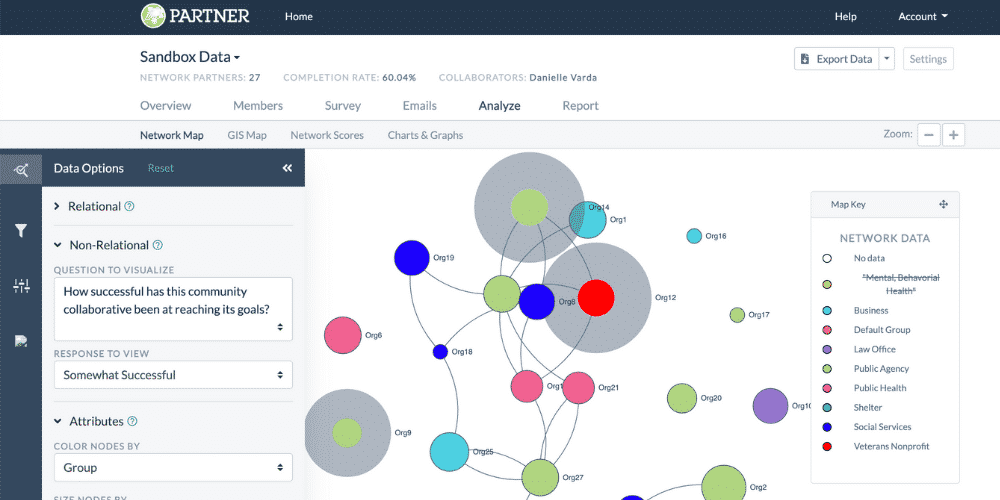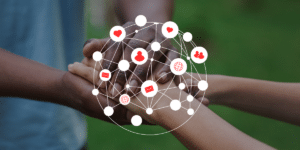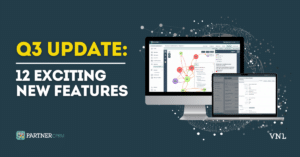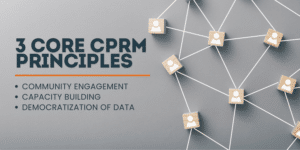
7 Things Social Network Analysis Can Teach You About Your Collaborative
Social network analysis (SNA) has been around for many decades in academic circles, but it has only recently become a popular learning tool for networks and other collaboratives. For many decades we have built partnerships and collaboratives largely based on gut and intuition, utilizing a ‘more is better’ mentality that suggests more partners and more integration will best help you reach your goals.
However, this approach quickly strains your time and resources, depriving you of any collaborative advantage you may have gained from your networking. Network analysis provides insight to guide you on both the whole-network level and for each partnership within it, helping you make more strategic networking decisions to drive social impact. Here are 9 specific things network analysis can teach you about your collaborative, coalition or network.
1) Can you structure your network more efficiently & strategically?
A network’s structure consists of the way you and your partners interconnect – a single set of 10 partners can form more than 100 unique structures, depending on the way they work together. For example, in a dense structure, each partner would be connected to all nine of their peers, so everyone works with everyone. In an open structure, each partner might only be connected directly to 2 or 3 peers, relying on these intermediaries to connect indirectly to others. Visualizing this network structure provides all kinds of insight, giving you a way to design a more efficient structure and track your progress in implementing it with your partners.
2) Where is trust strong, and where can it be strengthened?
Trust is the foundation of any collaborative relationship. Without trust, it’s difficult, if not impossible, to effectively function as a network and reach shared goals. A lack of trust has many negative impacts: it disincentivizes information and resource-sharing, creates more conflict over turf issues, and makes it harder to establish shared, authentic goals. Network analysis can identify which relationships are built on trust, and which need more focused attention to improve trust between partners.

3) To what degree do the members of your network agree?
In a network, each partner often views things a bit differently. Understanding how much your network’s members are ‘on the same page’ regarding their goals and progress is an important insight. Without alignment on your network purpose, your efforts are likely to be inefficient and effective. However, you may also find your network disagrees on your progress because they have a different definition of what success looks like. Bringing these differences to light through social network analysis allows you to do the work of bridging gaps and building alignment.
4) What resources & value do network members have to bring to the table?
We collaborate with networks because there is value in partnership. However that value comes in various shapes and sizes, with different ways to leverage each type of value. A social network analysis digs into value by asking each network member what they can bring to bear, along with their perceptions of the value of other partners. It’s important to consider not only tangible resources like funding and staff time, but also in-kind donations and less tangible value like mission alignment, time and energy, technical assistance, information and lived experiences.
5) What are network member’s perceptions of each other's power and influence?
Power is a major dynamic in any network, whether its members are individuals or organizations. It is closely related to issues of equity, as marginalized and under-represented groups are often seen as low-power, compared to large funders and national organizations. Mapping your network’s perceptions of one another’s power can help you try to equalize power imbalances, facilitate conversations and decision-making more equitably, and leverage your influential partners more effectively.

6) Which partnerships are attributed to your relationship-building work?
One way to evaluate the impact of your work is to measure how many relationships can be attributed to your relationship-building efforts. This metrics is a powerful way to demonstrate the importance of network building to help galvanize support and more resources for your network approach. You can also determine which relationships have been strengthened by your work, even if they pre-date the network.
7) What is helping the network succeed, and what are the main roadblocks?
While collecting SNA, you can ask your partners about what’s working, along with what barriers exist to network success. These answers can be layered with relational data to find patterns, like whether trust or value scores impact what barriers a partner thinks exist, or whether more centralized partners feel differently about success and progress than more peripheral partners. This is one more way to direct your attention towards specific parts of your network for improvement.
Learn more about using PARTNR for Social Network Analysis!
These 7 examples of social network analysis insights are only the tip of the iceberg. Conducting a network evaluation using PARTNER provides more than 15 pages of data, visualizations, questions to consider and potential action steps to translate your data to practice. If you feel like you need some guidance building, managing and evaluating your collaborative, consider whether social network analysis using a tool like PARTNER is the solution you’re looking for. Contact our team to learn more and see how we can help!




